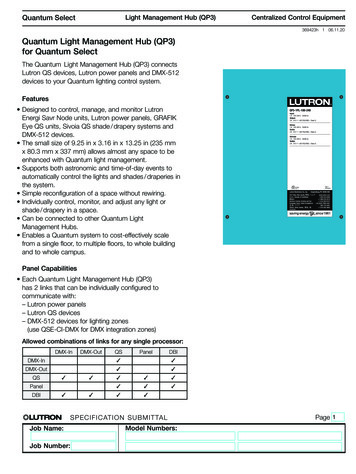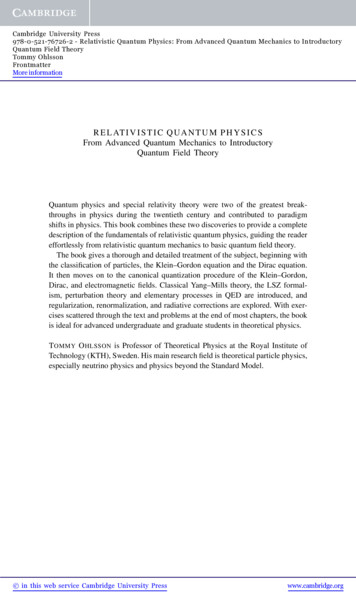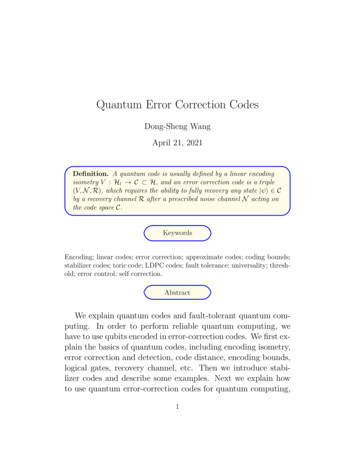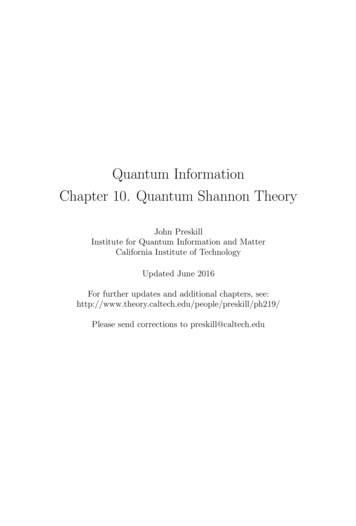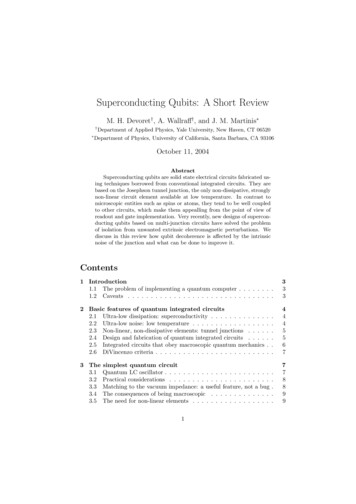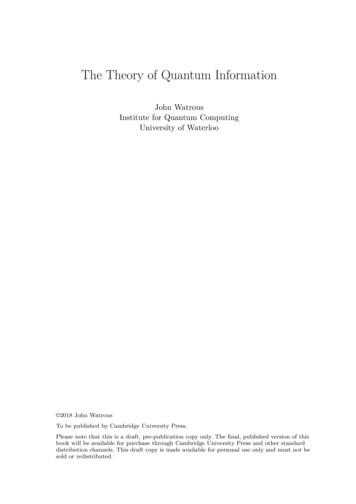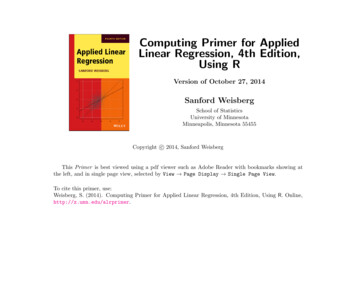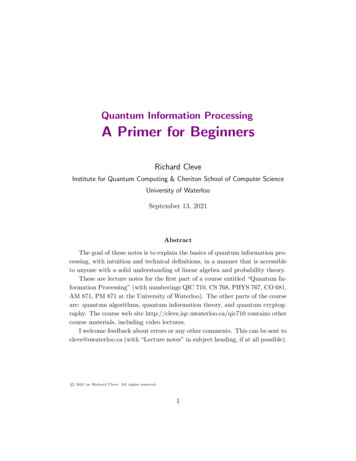
Transcription
Quantum Information ProcessingA Primer for BeginnersRichard CleveInstitute for Quantum Computing & Cheriton School of Computer ScienceUniversity of WaterlooSeptember 13, 2021AbstractThe goal of these notes is to explain the basics of quantum information processing, with intuition and technical definitions, in a manner that is accessibleto anyone with a solid understanding of linear algebra and probability theory.These are lecture notes for the first part of a course entitled “Quantum Information Processing” (with numberings QIC 710, CS 768, PHYS 767, CO 681,AM 871, PM 871 at the University of Waterloo). The other parts of the courseare: quantum algorithms, quantum information theory, and quantum cryptography. The course web site http://cleve.iqc.uwaterloo.ca/qic710 contains othercourse materials, including video lectures.I welcome feedback about errors or any other comments. This can be sent tocleve@uwaterloo.ca (with “Lecture notes” in subject heading, if at all possible). 2021 by Richard Cleve. All rights reserved.1
Contents1 Preface42 What is a qubit?2.1 A simple digital model of information . . . . . . . .2.2 A simple analog model of information . . . . . . . .2.3 A simple probabilistic digital model of information2.4 A simple quantum model of information . . . . . .4468103 Notation and terminology3.1 Notation for qubits (and higher dimensional analogues) . . . . . . . .3.2 A closer look at unitary operations . . . . . . . . . . . . . . . . . . .3.3 A closer look at measurements . . . . . . . . . . . . . . . . . . . . . .131315164 Introduction to state distinguishing problems185 On communicating a trit using a qubit5.1 Average-case success probability . . . . . . . . . . . . . . . . . . . . .5.2 Worst-case success probability . . . . . . . . . . . . . . . . . . . . . .2022236 Systems with multiple bits and multiple qubits6.1 Definitions of n-bit systems and n-qubit systems6.2 Subsystems of n-bit systems . . . . . . . . . . .6.3 Subsystems of n-qubit systems . . . . . . . . . .6.4 Product states . . . . . . . . . . . . . . . . . . .6.5 Aside: global phases . . . . . . . . . . . . . . .6.6 Local unitary operations . . . . . . . . . . . . .6.7 Controlled-U gates . . . . . . . . . . . . . . . .6.8 Controlled-NOT gate (a.k.a. CNOT) . . . . . . .2424262830333436387 Superdense coding7.1 Prelude to superdense coding . . . . . . . . . . . . . . . . . . . . . .7.2 How superdense coding works . . . . . . . . . . . . . . . . . . . . . .7.3 Normalization convention for quantum state vectors . . . . . . . . . .414143452.
8 Incomplete and local measurements8.1 Incomplete measurements . . . . . . . . . . . . . . . . . . . . . . . .8.2 Local measurements . . . . . . . . . . . . . . . . . . . . . . . . . . .8.3 Weirdness of the Bell basis encoding . . . . . . . . . . . . . . . . . .454547519 Exotic measurements9.1 Application to zero-error state distinguishing . . . . . . . . . . . . . .525310 Teleportation10.1 Prelude to teleportation . . . . . . . . . . . . . . . . . . . . . . . . .10.2 Teleportation scenario . . . . . . . . . . . . . . . . . . . . . . . . . .10.3 How teleportation works . . . . . . . . . . . . . . . . . . . . . . . . .5757575811 Can quantum states be copied?11.1 A classical bit copier . . . . . . . . . . . . . . . . . . . . . . . . . . .11.2 A qubit copier? . . . . . . . . . . . . . . . . . . . . . . . . . . . . . .6161613
1PrefaceThe goal here is to explain the basics of quantum information processing, with intuition and technical definitions. To be able to follow this, you need to have a solidunderstanding of linear algebra and probability theory. But no prior background inquantum information or quantum physics is assumed.You’ll see how information processing works on systems consisting of quantum bits(called qubits) and the kinds of manoeuvres that are possible with with them. You’llsee this in the context of some simple communication scenarios, including: state distinguishing problems, superdense coding, teleportation, and zero-error measurements.We’ll also consider the question whether quantum states can be copied.Although the examples considered here are simple toy problems, they are part of afoundation. This will help you internalize the more dramatic applications in quantumalgorithms, quantum information theory, and quantum cryptography, that you’ll beseeing in the later parts of the course.If you feel that you are past the beginner stage, please consider lookingat section 5, where we consider questions about communicating a trit usinga qubit—and there is some subtlety with that.2What is a qubit?In this section we are going to see how single quantum bits—called qubits—work.Some of you may have already seen that the state of a qubit can be represented asa 2-dimensional vector (or a 2 2 “density matrix”). Since there are a continuumof such possible states, it is natural to ask: Is a qubit digital or analog? How muchinformation is there in a qubit? Please keep these questions in mind, as we work ourway from bits to qubits.2.1A simple digital model of informationTo begin with, please take a moment to consider how to answer the question:What is a bit?4
Although a valid answer is that a bit is an element of {0, 1}, I’d like you to thinkof a bit in an operational way, as a system that can store an element of {0, 1} andfrom which the information can be retrieved. There are also other operations that wemight want to be able to perform on a bit, such as modifying the information storedin it in some systematic way.I happen to own a little 128 gigabyte USB flash drive that looks like this.Figure 1: My 128 GB USB flash drive.Think of a bit as a flash drive containing just one single bit of information. Let theblue box in figure 2 denote such a system.Figure 2: Think of a bit as a USB drive containing one single bit of information.We will imagine a few simple devices that perform operations on such bits. First,imagine a device that enables us to set the value of a bit to 0 or 1.Figure 3: A set device enables us to set a bit to 0 or 1.We plug our bit into that device and then we push one of the two green buttons toset the state to either 0 or 1. Suppose we push the button on the left to set the stateto 0.Later on, we (or someone else) might want to read the information stored in a bit.Imagine a read device that enables this.5
Figure 4: Plug a bit into a read device and push the activation button to see it’s value.We can plug the bit into that device and then push the activation button. This causesthe bit’s value to appear on a screen, so that we can see it.A third type of device is one that transforms the state of a bit in some way. Forexample, for a NOT device, we plug the bit in and, when we push the button, thestate of the bit flips (0 changes to 1 and 1 changes to 0).Figure 5: A NOT device enables us to flip the value of a bit.This transformation is called NOT because it performs a logical negation, where weassociate 0 with “false” and 1 with “true”. Note that, for this kind of operation,we don’t care about seeing what the value of the bit is, as long as that value getsnegated.OK, that’s more or less what conventional information processing is like—albeitwith many more bits in play and much more complicated operations.2.2A simple analog model of informationNext, let’s consider an analog information storage system. It has a continuum ofpossible states (perhaps a voltage that can be anywhere within some range). We canabstractly think of the state of the system as any real number between 0 and 1 (thatis, in the interval [0, 1]). We’ll use a different color to distinguish this from the bit.Figure 6: An analog USB drive that stores a value in the interval [0, 1].6
Let the red box in figure 6 represent such a system, an analog memory.Imagine a device that sets the state of the analog memory. We plug our systemFigure 7: An analog set device.into it. Suppose that there is some kind of dial that can be continuously rotated tospecify any number between 0 and 1. Then we press the activation button and thestate of the system becomes the value that we selected.We can also imagine reading the state of such a system. Here the read device hasFigure 8: An analog read device.an analog display depicted as a meter. When we press the button the needle goes toa position between 0 and 1, corresponding to the state.And we can also imagine an analog transformation that, when activated, appliesFigure 9: An analog f -transformation device.some function f : [0, 1] [0, 1] (for example, mapping x to x2 or x to 1 x).The real numbers are a mathematical idealization. In any implementation, therewill be a certain level of limited precision for all of the operations. But such analogdevices can be useful even if their precision isn’t perfect. Moreover, in principle,one could make the level of precision very high. The resulting system may be veryexpensive to manufacture, but it could contain a lot of information.7
2.3A simple probabilistic digital model of informationBefore considering quantum bits, let’s introduce randomness into our notion of a bit.Suppose that the state of our bit is the result of some random process, so there’sa probability that the system is in state 0 and a probability that it’s in state 1. Ofcourse the probabilities are greater than or equal to 0 and they sum to 1. Let’s putaside the question of what probabilities really mean. I’m going to assume that youalready have some understanding of this.Now imagine a new kind of device to randomly set the value of a bit, wheresome probability value, between 0 and 1, is selected by rotating a dial (within someprecision, of course).Figure 10: A probabilistic set device.When we activate, the bit gets set to 1 with the probability that we selected; andotherwise it gets set to 0.Now, from our perspective, if we know how the dial was set, there’s a specificprobability distribution, with components p0 and p1 , and the state of the system isbest described by this probability vector p0.(1)p1But note that the actual state is either 0 or 1 (we just don’t know which). Theprobability vector is a useful way for us to think about the state given what we know(and don’t know).Notice that the probabilistic digital model has an analog flavour. There are acontinuum of possible probability distributions. The set device for analog (figure 7)and the set device for probabilistic digital (figure 10) are superficially similar: theyboth have a dial for selecting a value between 0 and 1. However, what the devicesactually do is very different.Suppose that, later on, we insert our bit into a read device—which is the sameread device as in figure 4. After we press the activation button, the actual value of8
the bit appears on the screen. Once we see the value of the bit, we change whateverprobability vector we might have associated with it: the component correspondingto what we saw becomes 1 and the other component becomes 0. Let’s refer to thischange as the “collapse of the probability vector”.Note that, if we activate the read device a second time we will just see the samevalue we saw the first time—as opposed to another independent sample. To be clear,what the bit contains is the outcome of the original random process for setting thebit. It does not contain information about the random process itself.Also, if we didn’t know what probability values p0 and p1 were used when the bitwas set then reading the bit does not provide us with those values. After reading thebit, all we can do is make some statistical inferences. For example, if the outcomeof the read operation is 1 then we can deduce that p1 could not have been 0. Thisis very different from the analog model, where we can actually see the value of thecontinuously varying parameter using a read device.There are also transformations, like the NOT operation, and, more generally, any2 2 stochastic matrix makes sense as a transformation.Figure 11: A stochastic transformation, where S is some stochastic matrix.A 2 2 stochastic matrix is of the form s00 s01S ,s10 s11(2)where s00 , s01 , s10 , s11 0, s00 s10 1, s01 s11 1. In other words, each column ofS is a valid probability distribution. Applying S changes state 0 to [ ss0010 ] and state 1s01to [ s11 ]. If our knowledge of the state is summarized by the probability distribution[ pp01 ] then applying S changes our knowledge to S[ pp01 ].OK, that’s essentially what information processing with bits is like when we allowrandom operations (again, with many more bits in play and much more complicatedoperations).9
2.4A simple quantum model of informationSo how do quantum bits fit in? Are quantum bits like probabilistic bits or are theylike analog? In fact, they are neither of these. Quantum information is an entirelydifferent category of information. But it will be worth comparing it to probabilisticdigital and analog.A quantum bit (or qubit) has a probability amplitude associated with 0 and with 1.Probability amplitudes (called amplitudes for short) are different from probabilities.They can be negative—in fact they can be complex numbers. As long as they satisfy the condition that their absolute values squared sum to 1. In other words theamplitude vector, written here with components α0 and α1 , is a vector α0 C2(3)α1whose Euclidean1 length is 1 (also called a unit vector).OK, that’s a definition, but it’s natural to ask: what do these amplitudes actuallymean? Our approach to answering this question will be operational. What I meanby this is that we’ll consider what happens to qubits when basic operations similarto set, read, and transform are performed. We’ll develop an understanding of qubitsby seeing them in action.Later on, it will become clear that, unlike with probabilities, the explicit state ofa qubit is not 0 or 1; it works better to think of the amplitude vector [ αα01 ] as theexplicit state. In this one respect, quantum digital states resemble our analog system,where the explicit state is the continuous value.Now, let’s see qubits in action. We have our quantum memory, which we willdenote as a purple box, containing a qubit.Figure 12: A quantum memory containing a qubit.To begin with, imagine a device that enables us to set the state of a qubit to anyamplitude vector.10The Euclidean length of a vector [ αα1 ] is defined as10p α0 2 α1 2 .
Figure 13: Plug the qubit into a set device, set the dials, and then push the activation button toset the state of the qubit.The device has two dials that we can rotate. Why two? Because there are two realdegrees of freedom for all amplitude vectors: the amplitudes α0 and α1 (which arecomplex numbers) can be expressed in a polar formα0 sin(θ)iφα1 e cos(θ)(4)(5)which is in terms of two2 angles. So we can tune the two dials to specify any state(within some precision), and then we press the activation button and the qubit is setto the state that we specified.Next, the quantum analogue of the read device is called the measure device.Figure 14: Quantum measure device.We’re going to consider this device carefully. Recall that the state of the qubit isdescribed by an amplitude vector [ αα01 ]. What happens during a measurement is:1. The outcome displayed on the screen is either a 0 or a 1, with respective probabilities the α0 2 and α1 2 . Note that this makes perfect sense as a probabilitydistribution, because these quantities sum to 1.2. Also, the amplitude vector “collapses” towards the outcome in a manner similarto the way that a probability vector collapses when we read the value of a bit.The amplitude for the outcome becomes 1 and the other amplitude becomes 0.2Perhaps you noticed that there are actually three degrees of freedom; however, it turns out thatone of them doesn’t matter (this will be explained in section 6.5).11
For example, suppose we press the button and the outcome is 0 (an outcome thatoccurs with probability α0 2 ). Then 0 is displayed on the screen.Figure 15: Quantum measure device displaying outcome of measurement.Also, the state of the qubit changes from [ αα01 ] to [ 10 ]. The original amplitudes α0 andα1 are lost. In this sense, the measurement process is a destructive operation. Andthere’s no point in measuring the qubit a second time; we would just see the exactsame result—namely 0—again.It should be clear that, if we don’t know the state [ αα01 ] of a qubit, then measuringit does not enable us to extract the amplitudes α0 and α1 . In this respect, qubitsresemble the bits in our probabilistic digital system.Considering these two operations, set and measure, you might wonder: what’sthe point of these amplitudes? Amplitudes seem to be kind of like square roots ofprobabilities. When we measure, the absolute values of the amplitudes are squaredand we get a probabilistic sample. So what is the point of taking those square roots?In fact, if we stopped with these two operations, set and measure, then qubits wouldbe essentially the same as probabilistic bits.But qubits are interesting because we can also perform transformations like rotations on amplitude vectors, which essentially change the coordinate system in whichsubsequent measurements are made. Note that, if you rotate a vector of length 1, it’sstill a vector of length 1, so the validity of quantum states is preserved. In fact, theallowable transformations are unitary operations, which are kind of like “generalizedrotations”, and include operations like reflections too.Figure 16: A unitary operation, where U is a 2 2 unitary matrix.We’ll shortly see (in section 3.2) a formal definition of unitary and some interesting12
manoeuvres involving unitary operations.Together, these three kinds of operations—set, measure, and unitary—are essentially the building blocks of quantum information processing. We’ll see that allthe strange and interesting feats that can be performed in quantum informationand quantum computing are based on these operations—and similar ones involvingmore qubits.Now, a comment about terminology. What I’ve been calling “probabilistic” is commonly known as “classical”. The word “classical” is a reference to classical physics,the physics that existed before the advent of quantum physics. So we have classicalinformation and classical bits vs. quantum information and qubits.3Notation and terminologyWe now have a basic picture of how qubits work. But there are a few details to fill in,and we’ll spend a little time with that. And then we’ll consider the question of howmany much classical information can be communicated using a qubit (in section 5).There will be a surprise application, which is a concrete problem for which one singlequbit can accomplish something that cannot be accomplished with one single classicalbit.3.1Notation for qubits (and higher dimensional analogues)First, let’s briefly go over some notation and further terminology. Recall that the stateof a qubit is its amplitude vector, a unit vector [ αα01 ] C2 . This state is commonlydenoted using the bra-ket notation as α0 0i α1 1i (it’s also called the Dirac notation,after Paul Dirac). The strange looking parentheses (with the angle bracket on theright side) are called kets, and 0i and 1i are shorthand for the basis vectors, whichare orthonormal (where orthonormal means orthogonal and of unit length). Figure 17illustrates the geometric arrangement of the vectors 0i, 1i, and α0 0i α1 1i [ αα01 ]for a generic quantum state vector.13
0Figure 17: Geometric view of the computational basis states 0i, 1i, and a superposition [ αα1 ].Note that figure 17 is a schematic because [ αα01 ] C2 , rather than R2 . The basisvectors 0i and 1i are commonly referred to as the computational basis states. Forquantum states, the linear combinations α0 0i α1 1i are also called superpositions.More generally, in higher-dimensional systems (which will come up shortly), anysymbol within a ket denotes a column vector of unit length, like α0 α1 α (6) ψi 2 , . . . αd 1P2where d 1j 0 αj 1.A bra is like a ket, but written with the angle bracket on the left side, and itdenotes the conjugate transpose of the ket with the same label.Taking the conjugate transpose of a column vector yields a row vector whoseentries are the complex conjugates of the original entries, like hψ ᾱ0 ᾱ1 ᾱ2 · · · ᾱd 1 .(7)A bra is always a row vector of unit length.The inner product of a two kets is written as a bra-ket, or bracket, which can beviewed as shorthand for the product of a row matrix with a column matrix. If β0 β1 φi β2 .(8) . . βd 114
then the inner product of ψi and φi is the bracket hψ φi hψ · φi ᾱ0 ᾱ1 ᾱ2 · · · ᾱd 1 β0β1β2. . (9)βd 1Recall that, for inner products of complex-valued vectors, one takes the complexconjugates of the entries of one of the vectors.3.2A closer look at unitary operationsLet U be a square matrix. Here are three equivalent definitions of unitary.The first definition is in terms of a useful geometric property: U is unitary if itpreserves angles between unit vectors. For any two states, there is an angle betweenthem, which is determined by their inner product, and the property is expressed interms of inner products.Definition 3.1. A square matrix U is unitary if it preserves inner products. Thatis, for all ψ1 i and ψ2 i, the inner product between U ψ1 i and U ψ2 i is the same asthe inner product between ψ1 i and ψ2 i.The second definition makes it easy to recognize unitary matrices.Definition 3.2. A square matrix U is unitary if its columns are orthonormal (whichis equivalent to its rows being orthonormal).Some well-known examples of 2 2 unitary matrices are: the rotation by angle θ cos(θ) sin(θ)Rθ (10)sin(θ)cos(θ)and the Hadamard transform"H 12 1215 12 12#,(11)
which is not a rotation (but H is a reflection). Three further examples are the Paulimatrices3 01100 iX , Z , and Y .(12)100 1i0The Pauli X is sometimes referred to as a bit flip (or NOT operation), since X 0i 1iand X 1i 0i. Also, Z is sometimes referred to as a phase flip.The third definition of unitary, is useful in calculations and is commonly seen inthe literature.Definition 3.3. A square matrix U is unitary if U U I, where U is the conjugatetranspose4 of U (the transpose of U with all the entries conjugated).It remains to show that the above three definitions of unitary are equivalent:Exercise 3.1 (fairly straightforward). Show that the above three definitions of unitaryare indeed equivalent.3.3A closer look at measurementsNow, let’s look at measurements again. Let our qubit be in some state α0 0i α1 1i [ αα01 ] (where α0 2 α1 2 1). Then the result of the measurement is the following: With probability α0 2 , the outcome is 0 and the state collapses to 0i. With probability α1 2 , the outcome is 1 and the state collapses to 1i.Let’s look at this geometrically, in figure 18.Figure 18: The outcome probabilities of a measurement depend on the projection lengths squaredon the computational basis states.34An older notation for the Pauli matrices, commonly used in physics, is σX , σY , and σZ .An alternative notation for U , commonly used in physics, is U † .16
We have a 2-dimensional space with computational basis 0i and 1i. An arbitrarystate has a projection on each basis state. What happens in a measurement is thatthe state collapses to each basis state with probability equal to the projection-lengthsquared.The geometric perspective suggests some potential variations in our definition ofa measurement. For example, there’s no fundamental reason why the computationalbasis states should have special status. We can imagine basing a measurement onsome other orthonormal basis, different from the computational basis. For example,consider the orthonormal basis φ0 i and φ1 i in figure 19.Figure 19: Measurement with respect to an alternative basis, φ0 i and φ1 i.Any state has a projection on each basis vector and, although the projection lengthssquared are different for this basis, they still add up to 1. We can define a newmeasurement operation that projects the state being measured ψi to each thesebasis vectors with probability the projection lengths squared: With probability hψ φ0 i 2 , the outcome is 0 and the state collapses to φ0 i. With probability hψ φ1 i 2 , the outcome is 1 and the state collapses to φ1 i.One way of thinking about what unitary operations do is that they permit us toperform measurements with respect to any alternative orthonormal basis. We haveour basic measurement operation (which is with respect to the computational basis).If we want to perform a measurement with respect to a different orthonormal basis φ0 i U 0i and φ1 i U 1i then we carry out the following procedure:1. Apply U to map the alternative basis to the computational basis ( 0i and 1i).2. Perform a basic measurement (with respect to the computational basis).3. Apply U to appropriately adjust the collapsed state (to one of φ0 i and φ1 i).17
So that’s a nice way of seeing the role of unitary operations: they change the coordinate system, thereby releasing us from being tied to measuring in the computationalbasis.A final comment here is that there are more exotic measurements than this, wherethe state is first embedded into a larger-dimensional space. Then a unitary operationand measurement are made in that larger space. We’ll be seeing these types ofmeasurements later on, after we get to systems with multiple qubits (in section 9).4Introduction to state distinguishing problemsNow, let’s consider a simple problem involving qubits. Define the plus state andminus state as i i 12 12 0i 0i 12 12 1i(13) 1i .(14)What happens if a qubit in one of these states is measured? For i, since the squareFigure 20: Geometric depiction of the states 0i, 1i, i, and i.of 12 is 12 , the outcome is 0 with probability 12 and 1 with probability 21 . For i,since the square of 12 is also 12 , it’s the exactly the same probability distribution.Now, suppose that we’re given a qubit whose state is promised to be either i or i, but we’re not told which one. Is there a process for determining which one it is?The first observation is that just doing a basic measurement (which is in thecomputational basis) is useless. For either state, the result will be a random bit, withprobabilities 21 and 12 . There’s no distinction.But, since we can perform unitary operations, we are not shackled to the computational basis. We can apply a rotation by angle 45 degrees. This maps i to 1i and18
i to 0i. Then we measure in the computational basis, which perfectly distinguishesbetween the two cases.Here’s another, more subtle, state distinguishing problem to consider. Supposethat we are given either the 0i state or the i state. We’re promised that the stateis one of these two, but we’re not told which one. Note that the angle between thesestates is 45 degrees. Can we distinguish between these two cases?The problem with distinguishing between the 0i state and the i state is thatthey are not orthogonal—so there’s no unitary that takes one of them to 0i and theother to 1i (otherwise Definition 3.1 would be violated). And, in fact, there is noperfect distinguishing procedure.It turns out that two states can be perfectly distinguished if and only if they areorthogonal. I’m stating this now without proof, but when we get to the informationtheory part of the course, we’ll see some tools that make it easy to prove this.But, although we cannot perfectly distinguish between the i state and the istate, we might want a procedure that at least succeeds with high probability. Let’sconsider this problem.First note that there is a very trivial strategy, which is to output a random bit(without even measuring the state). This succeeds with probability 21 . So successprobability 12 is a baseline. Can we do better by making some measurement?What happens if we measure in the computational basis? The sensible thing todo in that case is to guess “0” if the outcome is 0 and guess “ ” if the outcome is 1.How well does this strategy perform? Its success probability depends on the instance:it’s 1 for the case of 0i and 12 for the case of i. We’ll next discuss two naturaloverall measures of success probability.One measure is the average-case success probability, which is respect to some priorprobability distribution on the instances. Suppose that this prior distribution is theuniform distribution (so the scenario is that I flip a fair coin to determine which of thetwo states to give you and your job is to perform some sort of measurement on thatstate and guess which state I gave you). With respect to this performance measure,the success probability of the above strategy is 21 · 1 21 · 21 34 . Notice that this isbetter than the baseline of 12 .Another overall measures of success probability is the worst-case success probability, which is the minimum success probability with respect to all instances. Noticethat the worst-case success probability of the above strategy is 12 , which is no betterthan the trivial strategy.Another strategy is to rotate by 45 degrees and then measure (and guess “0” if the19
outcome is 0 and guess “ ” if the outcome is 1). The performance of this strategyis complementary to the strategy of measuring with respect to the computationalbasis: it succeeds with probability 12 for the case of 0i and probability 1 for the caseof i. The average-case success probability of this is 34 and it’s worse case successprobability is 21 .Can we improve on this?Exercise 4.1 (fairly straightforward). Can you think of a simple way of combiningthe two strategies above to attain a worst-case success p
The goal here is to explain the basics of quantum information processing, with in-tuition and technical de nitions. To be able to follow this, you need to have a solid understanding of linear algebra and probability theory. But no prior background in quantum information or quantum physics is assumed.

